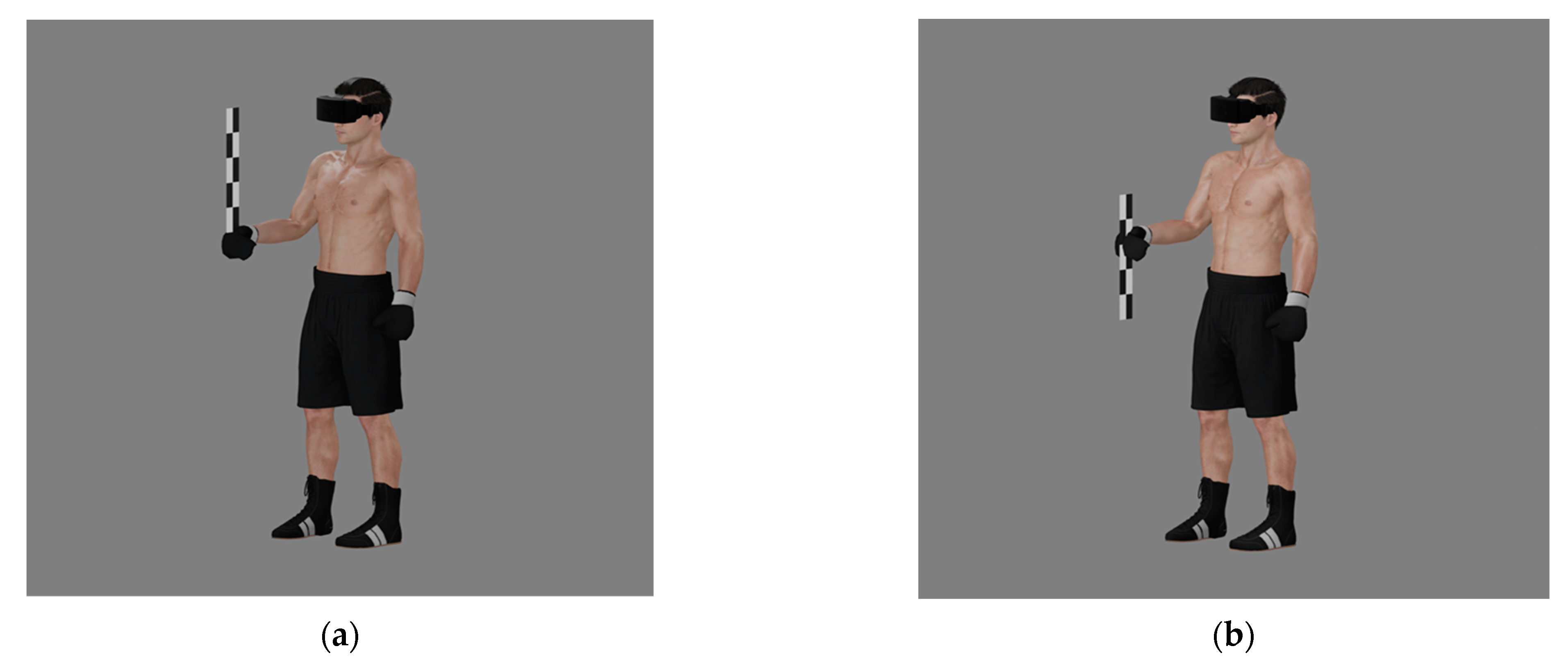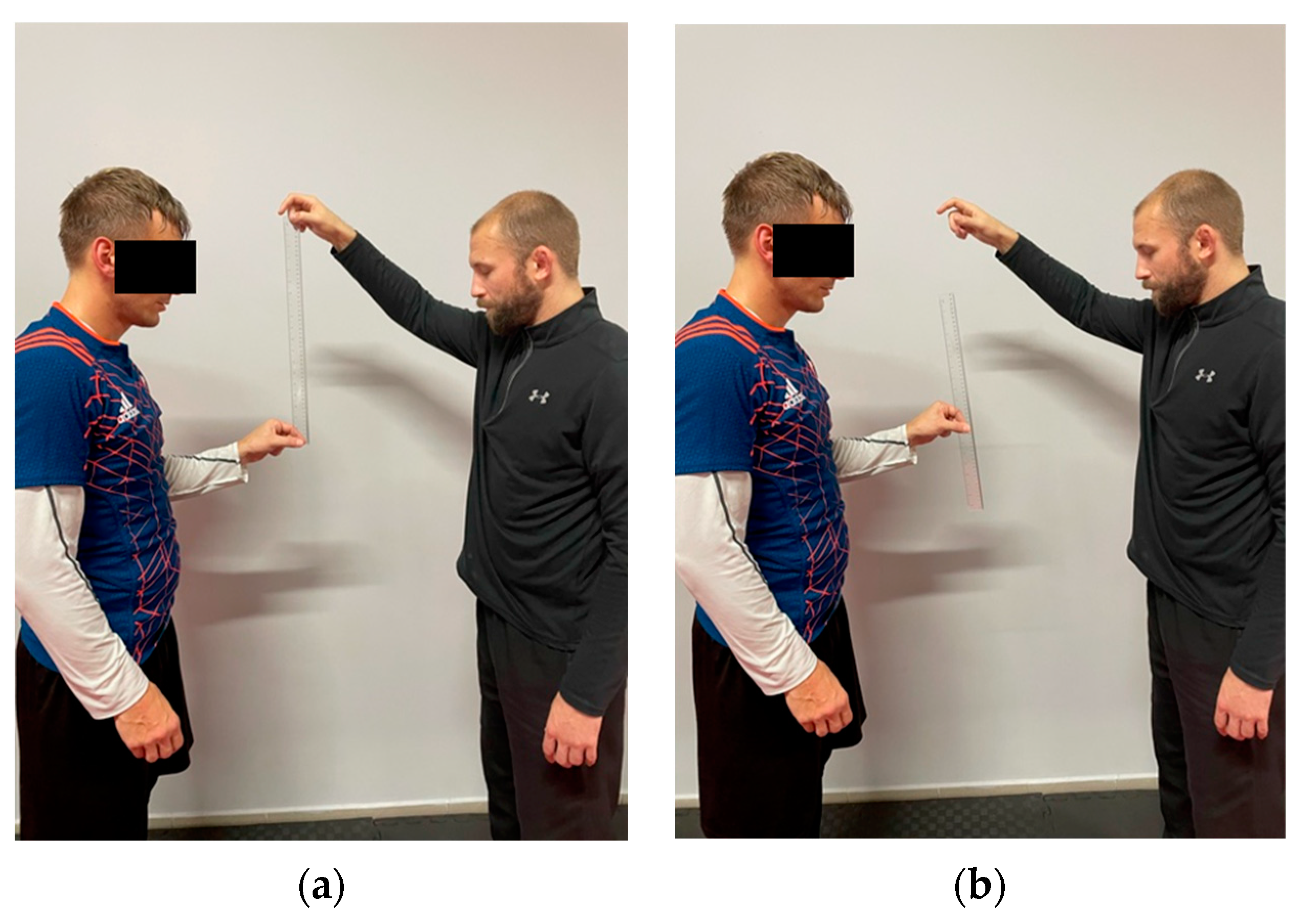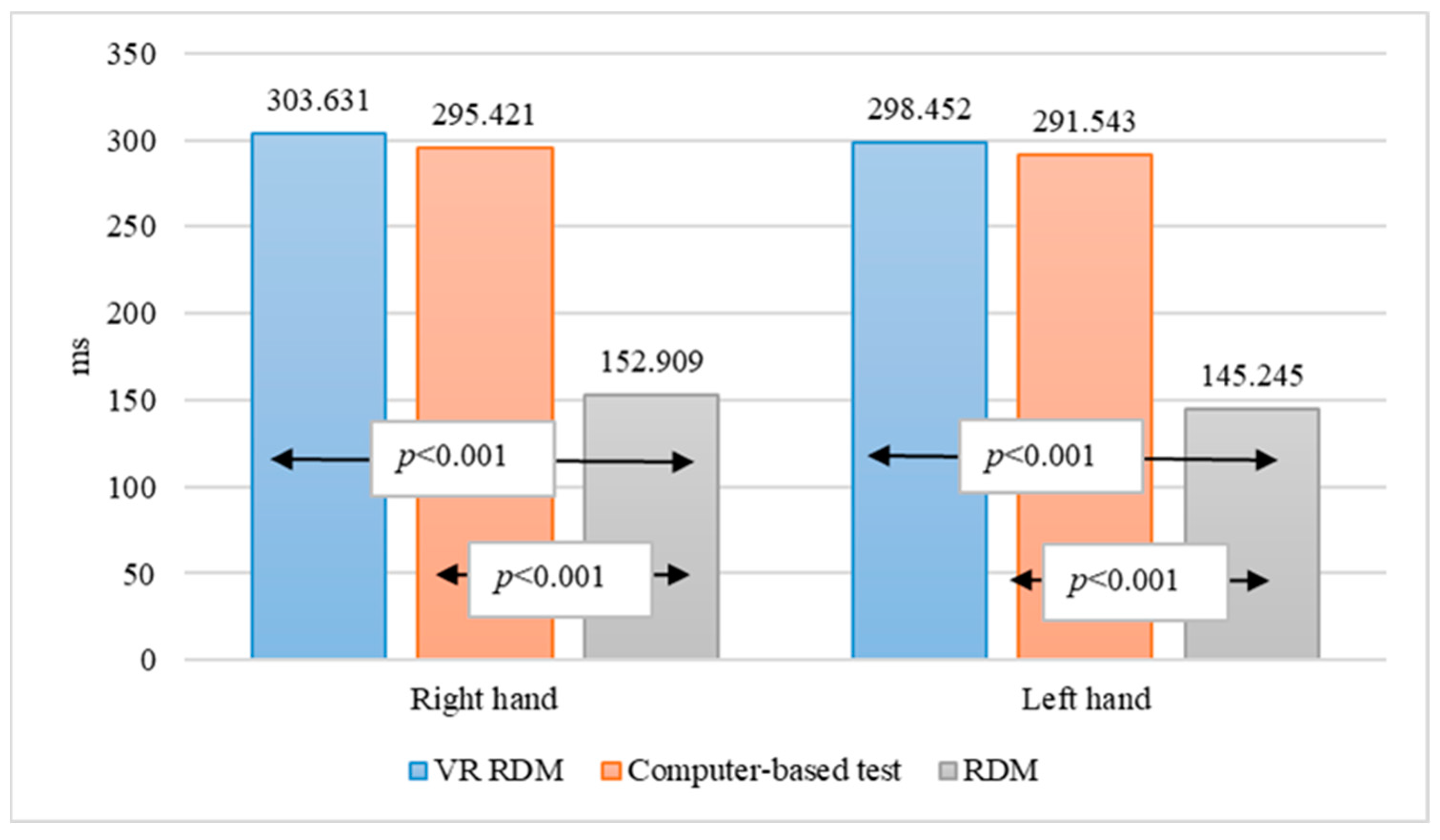Ruler Drop Method in Virtual Reality as an Accurate and Reliable Tool for Evaluation of Reaction Time of Mixed Martial Artists
Abstract
1. Introduction
2. Materials and Methods
2.1. Participants
2.2. Procedure
2.3. Statistical Analysis
3. Results
4. Discussion
5. Conclusions
Author Contributions
Funding
Institutional Review Board Statement
Informed Consent Statement
Data Availability Statement
Conflicts of Interest
References
- Jensen, P.; Roman, J.; Shaft, B.; Wrisberg, C. In the Cage: MMA Fighters’ Experience of Competition. Sport Psychol. 2013, 27, 1–12. [Google Scholar] [CrossRef]
- Gauthier, J. Ethical and Social Issues in Combat Sports: Should Combat Sports Be Banned? In Combat Sports Medicine; Kordi, R., Maffulli, N., Wroble, R.R., Wallace, W.A., Eds.; Springer: London, UK, 2009; pp. 73–88. ISBN 978-1-84800-354-5. [Google Scholar]
- Follmer, B.; Vidal Andreato, L.; Silveira Coswig, V. Combat-Ending Submission Techinques in Modern Mixed Martial Arts. Ido Mov. Culture. J. Martial Arts Anthropol. 2021, 21, 6–10. [Google Scholar] [CrossRef]
- Yoon, J. Physiological Profiles of Elite Senior Wrestlers. Sport. Med. 2002, 32, 225–233. [Google Scholar] [CrossRef] [PubMed]
- Radovanovic, D.; Milovan, B.; Nurkic, M.; Stankovic, N. Recovery of Dynamic Lung Function in Elite Judoists after Short-Term High Intensity Exercise. Arch. Budo 2011, 7, 21–26. [Google Scholar]
- La Bounty, P.; Campbell, B.I.; Galvan, E.; Cooke, M.; Antonio, J. Strength and Conditioning Considerations for Mixed Martial Arts. Strength Cond. J. 2011, 33, 56–67. [Google Scholar] [CrossRef]
- Langer, A.; Ignatieva, A.; Fischerova, P.; Nitychoruk, M.; Golas, A.; Maszczak, A. Effect of Post-Activation Potentiation on the Force, Power and Rate of Power and Force Development of the Upper Limbs in Mixed Martial Arts (MMA) Fighters, Taking into Account Training Experience. BJHPA 2022, 14, Article2. [Google Scholar] [CrossRef]
- Gierczuk, D.; Bujak, Z.; Rowiński, J.; Dmitriyev, A. Selected Coordination Motor Abilities in Elite Wrestlers and Taekwon-Do Competitors. Pol. J. Sport Tour. 2012, 19, 230–234. [Google Scholar] [CrossRef]
- Mirzaei, B.; Curby, D.G.; Barbas, I.; Lotfi, N. Anthropometric and Physical Fitness Traits of Four-Time World Greco-Roman Wrestling Champion in Relation to National Norms: A Case Study. JHSE 2011, 6, 406–413. [Google Scholar] [CrossRef]
- Balasubramaniam, M.; Sivapalan, K.; Nishanthi, V.; Kinthusa, S.; Dilani, M. Effect of Dual-Tasking on Visual and Auditory Simple Reaction Times. Indian J. Physiol. Pharm. 2015, 59, 194–198. [Google Scholar]
- Balkó, Š.; Borysiuk, Z.; Simonek, J. The Influence of Different Performance Level of Fencers on Simple and Choice Reaction Time. Rev. Bras. De Cineantropometria E Desempenho Hum. 2016, 18, 391–400. [Google Scholar] [CrossRef]
- Pavelka, R.; Třebický, V.; Fialová, J.T.; Zdobinský, A.; Coufalová, K.; Havlíček, J.; Tufano, J.J. Acute Fatigue Affects Reaction Times and Reaction Consistency in Mixed Martial Arts Fighters. PLoS ONE 2020, 15, e0227675. [Google Scholar] [CrossRef]
- Ignatjeva, A.; Nitychoruk, M.; Terbalyan, A.; Langer, A.; Wacek, A.; Maszczyk, A. The Effect of the Dynamics of External Load Changes in the Aspect of the Lower Limit Response Time of the Competitors of Mixed Martial Arts (MMA) Taking into Account Weight Categories and Sport Experience. BJHPA 2021, 13, 1–10. [Google Scholar] [CrossRef]
- Collier, T.; Johnson, A.; Ruggiero, J. Aggression in Mixed Martial Arts: An Analysis of the Likelihood of Winning a Decision. In Violence and Aggression in Sporting Contests: Economics, History, and Policy; Springer: New York, NY, USA, 2011; Volume 4. [Google Scholar]
- del Vecchio, F.B.; Hirata, S.M.; Franchini, E. A Review of Time-Motion Analysis and Combat Development in Mixed Martial Arts Matches at Regional Level Tournaments. Percept. Mot. Ski. 2011, 112, 639–648. [Google Scholar] [CrossRef]
- Isaev, A.V.; Korshunov, A.V.; Leonov, S.V.; Sanoyan, T.R.; Veraksa, A.N. Quantitative and Qualitative Indicators of Developing Anticipation Skills in Junior Wrestling Athletes. Procedia-Soc. Behav. Sci. 2016, 233, 186–191. [Google Scholar] [CrossRef][Green Version]
- Moriarity, J.; Collie, A.; Olson, D.; Buchanan, J.; Leary, P.; McStephen, M.; McCrory, P. A Prospective Controlled Study of Cognitive Function during an Amateur Boxing Tournament. Neurology 2004, 62, 1497–1502. [Google Scholar] [CrossRef] [PubMed]
- Akpina, S.; Zileli, R.; Senyüzlü, E.; Tunca, S.A. Anthropological and Perceptual Predictors Affecting the Ranking in Arm Wrestling Competition. Int. J. Morphol. 2013, 31, 832–838. [Google Scholar] [CrossRef][Green Version]
- Chung, P.; Ng, G. Taekwondo Training Improves the Neuromotor Excitability and Reaction of Large and Small Muscles. Phys. Ther. Sport 2012, 13, 163–169. [Google Scholar] [CrossRef] [PubMed]
- Badau, D.; Baydil, B.; Badau, A. Differences among Three Measures of Reaction Time Based on Hand Laterality in Individual Sports. Sports 2018, 6, 45. [Google Scholar] [CrossRef]
- Gavkare, A.M.; Surdi, A.D.; Nanaware, N.L. Auditory Reaction Time, Visual Reaction Time and Whole Body Reaction Time in Athletes. Indian Med. Gaz. 2013, 147, 214–219. [Google Scholar]
- Aranha, V.P.; Sharma, K.; Samuel, A.J.; Joshi, R.; Kumar, S.P. Reaction Time in Children by Ruler Drop Method: A Cross-Sectional Study Protocol. PER 2015, 3, 61–66. [Google Scholar] [CrossRef]
- van Schooten, K.S.; Duran, L.; Visschedijk, M.; Pijnappels, M.; Lord, S.R.; Richardson, J.; Delbaere, K. Catch the Ruler: Concurrent Validity and Test–Retest Reliability of the ReacStick Measures of Reaction Time and Inhibitory Executive Function in Older People. Aging Clin. Exp. Res. 2019, 31, 1147–1154. [Google Scholar] [CrossRef] [PubMed]
- Ahir, K.; Govani, K.; Gajera, R.; Shah, M. Application on Virtual Reality for Enhanced Education Learning, Military Training and Sports. Augment. Hum. Res. 2020, 5, 7. [Google Scholar] [CrossRef]
- Cao, L.; Peng, C.; Dong, Y. Ellic’s Exercise Class: Promoting Physical Activities during Exergaming with Immersive Virtual Reality. Virtual Real. 2021, 25, 597–612. [Google Scholar] [CrossRef]
- Polechoński, J.; Nierwińska, K.; Kalita, B.; Wodarski, P. Can Physical Activity in Immersive Virtual Reality Be Attractive and Have Sufficient Intensity to Meet Health Recommendations for Obese Children? A Pilot Study. Int. J. Environ. Res. Public Health 2020, 17, 8051. [Google Scholar] [CrossRef]
- Zhou, S. Using Virtual Reality to Promote Physical Activity. J. Softw. Eng. Appl. 2020, 13, 312–326. [Google Scholar] [CrossRef]
- Polechoński, J.; Zwierzchowska, A.; Makioła, Ł.; Groffik, D.; Kostorz, K. Handheld Weights as an Effective and Comfortable Way To Increase Exercise Intensity of Physical Activity in Virtual Reality: Empirical Study. JMIR Serious Games 2022, 10, e39932. [Google Scholar] [CrossRef]
- Zhang, X.; Shi, Y.; Bai, H. Immersive Virtual Reality Physical Education Instructional Patterns on the Foundation of Vision Sensor. J. Sens. 2021, 2021, e7752447. [Google Scholar] [CrossRef]
- Bauer, A.C.M.; Andringa, G. The Potential of Immersive Virtual Reality for Cognitive Training in Elderly. Gerontology 2020, 66, 614–623. [Google Scholar] [CrossRef]
- Polechoński, J.; Langer, A. Assessment of the Relevance and Reliability of Reaction Time Tests Performed in Immersive Virtual Reality by Mixed Martial Arts Fighters. Sensors 2022, 22, 4762. [Google Scholar] [CrossRef]
- Wojciechowski, A.; Wiśniewska, A.; Pyszora, A.; Liberacka-Dwojak, M.; Juszczyk, K. Virtual Reality Immersive Environments for Motor and Cognitive Training of Elderly People—A Scoping Review. Hum. Technol. 2021, 17, 145–163. [Google Scholar] [CrossRef]
- Bideau, B.; Multon, F.; Kulpa, R.; Fradet, L.; Arnaldi, B.; Delamarche, P. Using Virtual Reality to Analyze Links between Handball Thrower Kinematics and Goalkeeper’s Reactions. Neurosci. Lett. 2004, 372, 119–122. [Google Scholar] [CrossRef]
- Qian, J.; McDonough, D.J.; Gao, Z. The Effectiveness of Virtual Reality Exercise on Individual’s Physiological, Psychological and Rehabilitative Outcomes: A Systematic Review. Int. J. Environ. Res. Public Health 2020, 17, 4133. [Google Scholar] [CrossRef] [PubMed]
- Todorov, K.; Manolova, A.; Chervendinev, G. Immersion in Virtual Reality Video Games for Improving Physical Performance Measures: A Review. In Proceedings of the 2019 27th National Conference with International Participation (℡ECOM), Sofia, Bulgaria, 30–31 October 2019; pp. 35–38. [Google Scholar]
- Bird, J.M.; Karageorghis, C.I.; Baker, S.J.; Brookes, D.A.; Nowicky, A.V. Ready Exerciser One: Effects of Music and Virtual Reality on Cycle Ergometer Exercise. Br. J. Health Psychol. 2021, 26, 15–32. [Google Scholar] [CrossRef] [PubMed]
- McClure, C.; Schofield, D. Running Virtual: The Effect of Virtual Reality on Exercise. J. Hum. Sport Exerc. 2019, 15, 816–870. [Google Scholar] [CrossRef]
- Shoib, N.A.; Sunar, M.S.; Nor, N.N.M.; Azman, A.; Jamaludin, M.N.; Latip, H.F.M. Rowing Simulation Using Rower Machine in Virtual Reality. In Proceedings of the 2020 6th International Conference on Interactive Digital Media (ICIDM), Bandung, Indonesia, 14–15 December 2020; pp. 1–6. [Google Scholar]
- Zeng, N.; Liu, W.; Pope, Z.C.; McDonough, D.J.; Gao, Z. Acute Effects of Virtual Reality Exercise Biking on College Students’ Physical Responses. Res. Q. Exerc. Sport 2021, 93, 633–639. [Google Scholar] [CrossRef] [PubMed]
- Jochymczyk-Woźniak, K.; Nowakowska, K.; Polechoński, J.; Sładczyk, S.; Michnik, R. Physiological Gait versus Gait in VR on Multidirectional Treadmill—Comparative Analysis. Medicina 2019, 55, 517. [Google Scholar] [CrossRef]
- Wodarski, P.; Jurkojć, J.; Bieniek, A.; Chrzan, M.; Michnik, R.; Polechoński, J.; Gzik, M. The Analysis of the Influence of Virtual Reality on Parameters of Gait on a Treadmill According to Adjusted and Non-Adjusted Pace of the Visual Scenery. In Information Technology in Biomedicine; Pietka, E., Badura, P., Kawa, J., Wieclawek, W., Eds.; Springer International Publishing: Cham, Switzerland, 2019; pp. 543–553. [Google Scholar]
- Wodarski, P.; Jurkojć, J.; Polechoński, J.; Bieniek, A.; Chrzan, M.; Michnik, R.; Gzik, M. Assessment of Gait Stability and Preferred Walking Speed in Virtual Reality. Acta Bioeng. Biomech. 2020, 22, 127–134. [Google Scholar] [CrossRef]
- Vahle, N.M.; Unger, S.; Tomasik, M. Reaction Time-Based Cognitive Assessments in Virtual Reality–A Feasibility Study with an Age Diverse Sample. In Studies in Health Technology and Informatics; Röhrig, R., Beißbarth, T., König, J., Ose, C., Rauch, G., Sax, U., Schreiweis, B., Sedlmayr, M., Eds.; IOS Press: Amsterdam, The Netherlands, 2021; ISBN 978-1-64368-206-8. [Google Scholar]
- Miarka, B.; Coswig, V.S.; Amtmann, J. Long MMA Fights Technical-Tactical Analysis of Mixed Martial Arts: Implications for Assessment and Training. Int. J. Perform. Anal. Sport 2019, 19, 153–166. [Google Scholar] [CrossRef]
- Anitha, M.; Samuel, V.V. Reaction Time in Sitting and Standing Postures among Typical Young Adults. Physiother.-J. Indian Assoc. Physiother. 2018, 12, 58. [Google Scholar] [CrossRef]
- Klocek, T.; Spieszny, M.; Szczepanik, M. Computer Tests of Coordination Abilities; COS: Warszawa, Poland, 2002; ISBN 83-86504-89-7. [Google Scholar]
- Eckner, J.T.; Kutcher, J.S.; Richardson, J.K. Between-Seasons Test-Retest Reliability of Clinically Measured Reaction Time in National Collegiate Athletic Association Division I Athletes. J. Athl. Train. 2011, 46, 409–414. [Google Scholar] [CrossRef]
- Shrout, P.E.; Fleiss, J.L. Intraclass Correlations: Uses in Assessing Rater Reliability. Psychol. Bull. 1979, 86, 420–428. [Google Scholar] [CrossRef] [PubMed]
- Koo, T.K.; Li, M.Y. A Guideline of Selecting and Reporting Intraclass Correlation Coefficients for Reliability Research. J. Chiropr. Med. 2016, 15, 155–163. [Google Scholar] [CrossRef]
- Cole, W.R.; Arrieux, J.P.; Schwab, K.; Ivins, B.J.; Qashu, F.M.; Lewis, S.C. Test-Retest Reliability of Four Computerized Neurocognitive Assessment Tools in an Active Duty Military Population. Arch. Clin. Neuropsychol. 2013, 28, 732–742. [Google Scholar] [CrossRef] [PubMed]
- Lezak, M.D.; Howieson, D.B.; Bigler, E.D.; Tranel, D. Neuropsychological Assessment; Oxford University Press: Oxford, UK, 2012; ISBN 978-0-19-539552-5. [Google Scholar]
- Warnick, J.E.; Warnick, K. Specification of Variables Predictive of Victories in the Sport of Boxing. Percept. Mot. Ski. 2007, 105, 153–158. [Google Scholar] [CrossRef]
- Warnick, J.E.; Warnick, K. Specification of Variables Predictive of Victories in the Sport of Boxing: II. Further Characterization of Previous Success. Percept. Mot. Ski. 2009, 108, 137–138. [Google Scholar] [CrossRef]
- Darby, D.; Moriarity, J.; Pietrzak, R.; Kutcher, J.; Mcaward, K.; Mccrory, P. Prediction of Winning Amateur Boxers Using Pretournament Reaction Times. J. Sport. Med. Phys. Fit. 2014, 54, 8. [Google Scholar]
- Holden, J.; Francisco, E.; Lensch, R.; Tommerdahl, A.; Kirsch, B.; Zai, L.; Dennis, R.; Tommerdahl, M. Accuracy of Different Modalities of Reaction Time Testing: Implications for Online Cognitive Assessment Tools. bioRxiv 2019, 726364. [Google Scholar] [CrossRef]
- Hinkle, D.E.; Wiersma, W.; Jurs, S.G. Applied Statistics for the Behavioral Sciences, 5th ed.; Houghton Mifflin: Boston, MA, USA, 2003; ISBN 978-0-618-12405-3. [Google Scholar]
- Shepherd, J.; Carter, L.; Pepping, G.-J.; Potter, L.-E. Towards an Operational Framework for Designing Training Based Sports Virtual Reality Performance Simulators. Proceedings 2018, 2, 214. [Google Scholar] [CrossRef]
- Del Rossi, G. Evaluating the Recovery Curve for Clinically Assessed Reaction Time After Concussion. J. Athl. Train. 2017, 52, 766–770. [Google Scholar] [CrossRef]
- Eckner, J.T.; Kutcher, J.S.; Richardson, J.K. Effect of Concussion on Clinically Measured Reaction Time in Nine NCAA Division I Collegiate Athletes: A Preliminary Study. PM&R 2011, 3, 212–218. [Google Scholar] [CrossRef]
- Eckner, J.T.; Kutcher, J.S.; Broglio, S.P.; Richardson, J.K. Effect of Sport-Related Concussion on Clinically Measured Simple Reaction Time. Br. J. Sport. Med. 2014, 48, 112–118. [Google Scholar] [CrossRef] [PubMed]
- MacDonald, J.; Wilson, J.; Young, J.; Duerson, D.; Swisher, G.; Collins, C.L.; Meehan, W.P. Evaluation of a Simple Test of Reaction Time for Baseline Concussion Testing in a Population of High School Athletes. Clin. J. Sport. Med. 2015, 25, 43–48. [Google Scholar] [CrossRef] [PubMed]
- Eckner, J.T.; Chandran, S.; Richardson, J.K. Investigating the Role of Feedback and Motivation in Clinical Reaction Time Assessment. PM&R 2011, 3, 1092–1097. [Google Scholar] [CrossRef]
- Jha, R.K.; Thapa, S.; Kasti, R.; Nepal, O. Influence of Body Mass Index, Handedness and Gender on Ruler Drop Method Reaction Time among Adults. J. Nepal. Health Res. Counc. 2020, 18, 108–111. [Google Scholar] [CrossRef] [PubMed]
- Neumann, D.L.; Moffitt, R.L.; Thomas, P.R.; Loveday, K.; Watling, D.P.; Lombard, C.L.; Antonova, S.; Tremeer, M.A. A Systematic Review of the Application of Interactive Virtual Reality to Sport. Virtual Real. 2018, 22, 183–198. [Google Scholar] [CrossRef]
- Singh, P.I.; Maini, B.K.; Singh, I. Bilateral Asymmetry in Conduction Velocity in the Efferent Fibres of the Median Nerve Andits Relationship to Handedness. Indian J. Physiol. Pharm. 1977, 21, 364–368. [Google Scholar]
- Loturco, I.; Franchini, E.; Cal Abad, C.C. A Comparative Study of Specific Reaction Time in Elite Boxers: Differences between Jabs and Crosses. J. Athl. Enhanc. 2015, 4, 1–4. [Google Scholar] [CrossRef]
- Pastel, S.; Bürger, D.; Chen, C.H.; Petri, K.; Witte, K. Comparison of Spatial Orientation Skill between Real and Virtual Environment. Virtual Real. 2022, 26, 91–104. [Google Scholar] [CrossRef]
- Kennedy, R.S.; Lane, N.E.; Berbaum, K.S.; Lilienthal, M.G. Simulator Sickness Questionnaire: An Enhanced Method for Quantifying Simulator Sickness. Int. J. Aviat. Psychol. 1993, 3, 203–220. [Google Scholar] [CrossRef]



| Type of Test | 1. | 2. | 3. | 4. | 5. | 6. |
|---|---|---|---|---|---|---|
| 1. VR RDM (right hand) | 0.740 * | 0.767 * | 0.699 * | 0.468 * | 0.441 * | |
| 2. VR RDM (left hand) | 0.676 * | 0.683 * | 0.374 * | 0.474 * | ||
| 3. Computer-based test (right hand) | 0.871 * | 0.471 * | 0.412 * | |||
| 4. Computer-based test (left hand) | 0.451 * | 0.402 * | ||||
| 5. RDM—(right hand) | 0.634 * | |||||
| 6. RDM—(left hand) |
| Type of Test | ICC | p |
|---|---|---|
| VR RDM (right hand) | 0.783 | 0.001 |
| VR RDM (left hand) | 0.710 | 0.001 |
| Computer-based test (right hand) | 0.800 | 0.001 |
| Computer-based test (left hand) | 0.845 | 0.001 |
| RDM—(right hand) | 0.734 | 0.001 |
| RDM—(left hand) | 0.852 | 0.001 |
Disclaimer/Publisher’s Note: The statements, opinions and data contained in all publications are solely those of the individual author(s) and contributor(s) and not of MDPI and/or the editor(s). MDPI and/or the editor(s) disclaim responsibility for any injury to people or property resulting from any ideas, methods, instructions or products referred to in the content. |
© 2022 by the authors. Licensee MDPI, Basel, Switzerland. This article is an open access article distributed under the terms and conditions of the Creative Commons Attribution (CC BY) license (https://creativecommons.org/licenses/by/4.0/).
Share and Cite
Langer, A.; Polechoński, J.; Polechoński, P.; Cholewa, J. Ruler Drop Method in Virtual Reality as an Accurate and Reliable Tool for Evaluation of Reaction Time of Mixed Martial Artists. Sustainability 2023, 15, 648. https://doi.org/10.3390/su15010648
Langer A, Polechoński J, Polechoński P, Cholewa J. Ruler Drop Method in Virtual Reality as an Accurate and Reliable Tool for Evaluation of Reaction Time of Mixed Martial Artists. Sustainability. 2023; 15(1):648. https://doi.org/10.3390/su15010648
Chicago/Turabian StyleLanger, Alan, Jacek Polechoński, Piotr Polechoński, and Jarosław Cholewa. 2023. "Ruler Drop Method in Virtual Reality as an Accurate and Reliable Tool for Evaluation of Reaction Time of Mixed Martial Artists" Sustainability 15, no. 1: 648. https://doi.org/10.3390/su15010648
APA StyleLanger, A., Polechoński, J., Polechoński, P., & Cholewa, J. (2023). Ruler Drop Method in Virtual Reality as an Accurate and Reliable Tool for Evaluation of Reaction Time of Mixed Martial Artists. Sustainability, 15(1), 648. https://doi.org/10.3390/su15010648







